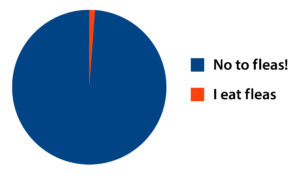I bet if I did a survey that asked people what the worst part of summer is; the majority of us would agree that it’s the plethora of biting flies, mosquitoes, spiders and other insects. That includes fleas and the onset of heartworm, flea and tick season.

Since starting work at the clinic, I’ve spent far too much time wondering what is the point of the flea? I mean, in the grand scheme of things; do they serve a greater purpose? The “Circle of Life” theme song has started running through my head. I need to know. If you’re reading this article, you’re just as inquisitive. So, let the games begin!
- Are fleas omnivores (possibly controlling the population of an invasive species)? No.
- Are fleas predatory (feeding on other parasitic insects)? No.
- Do fleas help pollinate plants? No.
- Are fleas decomposers? It’s plausible.
- Can fleas be eaten? YES! Curiosity peaked!
Fleas can lay up to 50 eggs per day – with the average being between 20 to 30. That’d make a tidy snack for many amphibians, reptiles, or birds. Worst of all, they can be eaten by your pet. Suddenly, your pet grooming themselves doesn’t seem so harmless.
You see, with help from my friend “Google,” I’ve recently learned that developing fleas eat tapeworm eggs. Yum-Yum (not really). After being digested, the flea carcass dissolves and releases said tapeworm egg. So, now your pet has fleas and tapeworms.
Not only do fleas carry tapeworm eggs; they also carry diseases like cat scratch disease and even the plague! If left untreated it can also cause anemia in your pet. Any of the aforementioned could cripple any living being.
I’ve learned a lot while writing this article and, as the Circle of Life still circles in my head, I’ll end this article by saying stay safe my friends! ~ Hakuna Matata
Written by: Melanie Hamilton, Customer Care Representative




